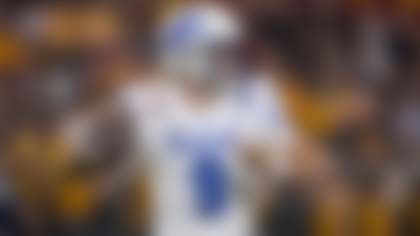It's draft week! Around the NFL, prospect evaluations are complete, draft boards set. And after a month-plus of wheeling and dealing in free agency, each team's needs and position priorities can be more easily weighed against the draft order. Of course, it won't take long on draft night for a few trades to blow up everyone's best-laid mock drafts.
Yes, trades are a major component of the madness that is draft weekend. And when teams are conjuring up deals, many reference a chart created back in the 1990s by Jimmy Johnson which quantifies the value of each draft slot. Now, obviously, there are market dynamics that influence pick trades (like actually finding a trade partner and agreeing on terms), but that chart provides great context when it comes to understanding more about how a trade is initially valued. Some things, like the exact value of a pick in a future year, can never be fully taken into account because the draft order changes every year.
Remember, there are a number of different draft philosophies: some teams believe in amassing lots of picks, others like to package their picks to select a specific player. Some teams have very short lists of prospects they're targeting, others have hundreds of prospects ordered on their board. This article isn't an optimal team draft strategy -- this is a market analysis using the current draft order and equity for each team. For example, the Raiders have three first-round picks (and four in the first 35 slots), while the Packers and Giants each have two 1s. And then there are the Bears, who don't pick until the third round.
The work below blends my draft-prospect and team-needs models to provide competitive analysis of each pick. This piece builds off how I approached my mock draft in that its goal is to optimize for wins this season. In areas where there is surplus value, a future draft pick is mentioned. The idea here is to pretend I am working for a team and tasked with analyzing what could happen at each pick using a lot of contextual data.
With all of that in mind, below you'll find four potential efficient trades involving high-value selections. These deals would provide the most value for both teams. This means trades that net both teams a higher projected win total, while taking into account who other teams are likely to draft.
NOTE: No trades with players and picks packaged together were included in this analysis.
1) The Texans trade up for an O-lineman
Houston Texans receive:
-- 2019 first-round pick (No. 16 overall)
Carolina Panthers receive:
-- 2019 first-round pick (No. 23)
-- 2019 second-round pick (No. 55)
Why it works for the Texans: The model suggests the Texans optimize for wins if they prioritize an improvement on the offensive line in Round 1. Fortunately, they have two second-rounders (Nos. 54 and 55), so they can afford to use one to move up. The likelihood of my model's two highest-rated offensive linemen (Jawaan Taylor, Jonah Williams) being available is above average, until the Vikings (No. 18) and Seahawks (No. 21) are on the clock. The Jaguars (No. 7) and Broncos (No. 10) pose the greatest risks before No. 16.
Why it works for the Panthers: For the cost of just seven selections in the first round, they pick up an additional second-rounder. The Panthers have a strong core of starters, so modeling scenarios where they trade up doesn't yield as much value as focusing more attention on the end of the first and second rounds where they could add quality players who wouldn't necessarily be asked to be Day 1 starters. My model projects Carolina would be able to add value in pass defense (corner and pass rush, specifically) and select a Day 1-starting wide receiver with pick Nos. 23, 47 and 55.
2) The Patriots move up for a coveted player
UPDATE: The Seahawks have agreed to trade Frank Clark to the Chiefs in exchange for Kansas City's 2019 first-round pick (No. 29) and a 2020 second-round pick. The trade increases the Seahawks' 2019 pick total to five selections.
New England Patriots receive:
-- 2019 first-round pick (No. 21 overall)
Seattle Seahawks receive:
-- 2019 first-round pick (No. 32)
-- 2019 third-round picks (Nos. 97 and 101)
Why it works for the Patriots: The Patriots have 12 total picks in the draft, including six in the first three rounds. With this type of equity, they have the flexibility to move up and acquire a player they really value at No. 21 -- perhaps someone like safety Johnathan Abram or edge rusher Brian Burns. They could also package even more picks together to move ahead of the Texans and draft offensive tackle Jonah Williams should he still be available, but that type of move up the draft board is not something we've typically seen from Bill Belichick.
Why it works for the Seahawks: The Seahawks have the fewest total picks (4) in the 2019 NFL Draft, and they just made their quarterback, Russell Wilson, the highest-paid player in the NFL. So, they could certainly use a few more quality picks to help build out their roster. At Nos. 32, 97 and 101, the Seahawks still project to be able to add first-round talent to their offensive line and improve their overall defense for the cost of 11 late-first-round slots.
3) The Bills go after my highest-rated prospect
Buffalo Bills receive:
-- 2019 first-round pick (No. 2 overall)
-- 2019 sixth-round pick (No. 176)
San Francisco 49ers receive:
-- 2019 first-round pick (No. 9)
-- 2019 fifth-round pick (No. 147)
-- 2019 sixth-round pick (No. 181)
-- 2020 first-round pick (valued at approximately pick No. 12)
Why it works for the Bills: With most mock drafts connecting Kyler Murray to the Cardinals at the first overall pick, and the Raiders sitting at No. 4 with several key needs (and the capital to move all over the draft board), the strategy for the 49ers at No. 2 and Jets at No. 3 is very interesting. Since trading with the Jets would be an in-division move, the Bills are more likely to work with the Niners on a deal. Should my model's highest-rated player, Quinnen Williams, be available at No. 2, the Bills could craft a trade for the Alabama defensive tackle and fill a huge team need; though, the trade would require giving up their first-round pick in 2020. I told you that my model is most focused on winning this season, but that doesn't mean it doesn't consider future seasons at all. Simply put, the opportunity to draft Williams is worth the future costs, given the premium at his position and the Bills' current roster.
Why it works for the 49ers: In this scenario, the Niners limit their odds of acquiring one of the premium pass rushers in the 2019 draft, but at ninth overall, they still have the ability to address their pass defense. With quarterback Jimmy Garoppolo returning from injury and the offseason defensive additions of Dee Ford and Kwon Alexander, the 49ers created options for this season and added value for 2020. Should they have a top-10 valuation on a corner (Deandre Baker is a CB my model likes for them), they could pull the trigger at No. 9. However, depending on the quarterback market (for example, do the Giants take a QB at No. 6?), San Francisco could spin this pick into even more draft capital, as the team would now sit one slot ahead of the Broncos, who could be in play for a young signal-caller.
4) Should the Giants not go QB at No. 6, the Redskins trade up to No. 8
Washington Redskins receive:
-- 2019 first-round pick (No. 8)
-- 2019 fourth-round pick (No. 111)
Detroit Lions receive:
-- 2019 first-round pick (No. 15)
-- 2019 second-round pick (No. 46)
Why it works for the Redskins: If you take the time to add up Jimmy Johnson's trade-value chart you'll see that the Lions earn more equity than the Redskins by about 18 points. This reflects the "should" part of the statement above. This means that in order to get the second quarterback drafted on Day 1, the Redskins have to give up a little more in the trade. If Washington is targeting the quarterback position, this is likely the least it will have to pay to fill the position with anyone other than Kyler Murray (who is likely to go first overall). It's likely that the Redskins have a number of paths mapped out for acquiring the QB they want, but this would be the trade where both teams benefit the most.
Why it works for the Lions: The Lions would pick at Nos. 15, 43 and 46 in this scenario. My model forecasts that the blend of corners, pass rushers, tight ends and wide receivers available in these slots would address the Lions' needs most fully. Since this trade is contingent on only one quarterback being selected, this likely means that the premium pass rushers are off the board, and thus Detroit would get more value with a top, scheme-fit corner (Greedy Williams?) in the first round. The Lions could then use their two second-round selections on a pass rusher and tight end/wide receiver. If tight end T.J. Hockenson is available at No. 15, Detroit could snag him and use their second-rounders on a corner and pass rusher.
Three QB situations to monitor
3) If the Redskins believe their franchise QB is in this class (and not Kyler Murray, who appears to be the probable No. 1 pick), they likely won't risk waiting until pick No. 8 to snag him, even though, as I outlined above, that would be the most efficient trade option for both sides of that kind of deal. This means likely working with either the 49ers (No. 2) or the Jets (No. 3) and including a 2020 first-round pick.
BONUS: Three overall observations
1) The Jaguars are in a great position to derive exceptional value from this draft (especially with the 7th and 38th overall picks). If there is a run on pass rushers or quarterbacks at the top of the draft, the Jaguars will be well-positioned to take advantage in the form of trading down and acquiring more picks. Their offseason addition of quarterback Nick Foles, along with their strong defense, gives the Jags tons of flexibility and leverage in the 2019 draft.
2) It seems unlikely the Raiders will pick at Nos. 4, 24, 27 and 35. I fully expect Oakland to be active in the trade market. The Raiders have a lot of needs, so the better they are at assessing their options as players come off the board the more efficient their trades can be. They could also be a main driver in shaping the quarterback market. In my models, they get the biggest win return if they focus on defense in Round 1, including trading up into the teens for one of the draft's more impactful defensive players.
3) The Packers -- who own pick Nos. 12, 30 and 44 -- also have the potential to be very disruptive on Day 1. They have 10 total picks (as of now) and could go in a number of different directions after focusing primarily on their defense in free agency. Obviously, all picks don't result in perfect-fit players, but Green Bay has the most flexibility in the NFC North (especially considering the Bears' first pick is at No. 87), so I expect we see the Pack trade out of at least one of the aforementioned picks.
Follow Cynthia Frelund on Twitter @cfrelund.












